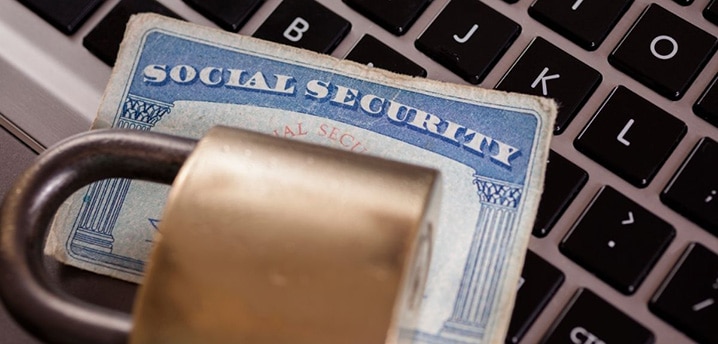Your identity has value to fraudsters, hackers, and thieves. Learn how to protect it from ID theft.
When you apply for loans, pay your taxes, or take out credit cards, companies and institutions use personal data such as your name, birthdate, Social Security number, and other personally identifiable information (PII) to determine who you are.
This PII represents your identity and plays a major role throughout your life. But what happens if another individual steals your PII and uses it for their own purposes?
Identity theft, or ID theft, occurs when an unauthorized party uses your information to commit fraud, such as using your PII to apply for a loan or to collect benefits you’re entitled to (even if you’re not currently collecting them yourself).
Let’s look at how you can recognize, avoid, and recover from identity theft and safeguard your financial wellbeing.
Types of Identity Theft
The Federal Trade Commission (FTC), which operates the Consumer Sentinel Network, recorded 1.4 million complaints of identity theft in 2021, making up 25% of all of its reports. Cases of identity theft typically fall into one of several categories:
- Financial identity theft: the most common form of identity theft, in which someone uses your PII for financial gain, such as using your bank account number or credit card number to make a purchase or your Social Security number to open a new loan.
- Tax identity theft: when someone uses your PII to file a tax return and steal your tax refund.
- Medical identity theft: when someone uses your PII to receive medical care in your name or send a fake bill to your insurer.
- Employment identity theft: when someone uses your PII to get a job or pass a background check.
- Child identity theft: when someone uses PII belonging to a child to apply for credit or open accounts in their name.
- Estate identity theft: when someone uses the PII of a deceased person to open accounts in their name or to steal money.
- Criminal identity theft: when someone provides law enforcement with your PII instead of their own, such as when they receive a traffic ticket or are arrested.
- Synthetic identity theft: when someone combines real PII with fake information, such as using your Social Security number with a fake name.
Though criminals rely on fraudulent behavior to steal your identity, identity theft itself isn’t fraud. However, actions that result from identity theft — such as someone using your PII to open a bank account without your knowledge or authorization — are acts of fraud.
When Can Identity Theft Happen?
Identity theft can occur at any time. However, criminals often prey on you when you’re most vulnerable, either because your guard is down or because an event takes place that exposes your sensitive information.
As a child
Children don’t typically have credit reports, which means it’s less likely for a parent to spot child identity theft. Criminals may use a child’s PII to open up new accounts, apply for utility services, receive government benefits, and engage in other fraudulent behavior — all of which will eventually impact the child’s credit.
As a millennial or member of Gen Z
25% of millennials and 24% of Gen Zers have had their identities stolen, whereas only 14% of baby boomers have experienced identity theft. Though statistics may be skewed because younger generations more easily recognize signs of identity theft, the younger generations’ tendency to overshare creates additional vulnerabilities that fraudsters can take advantage of.
When buying a home
Buying a house requires you to share heaps of personal information and data. Your name, birthday, proof of employment, address, Social Security number, and banking information is all shared with multiple parties when looking for homes, selling your own, and applying for a mortgage.
After getting married
Getting married is incredibly personal, which means sharing details about your life with family, friends, guests, and service providers. In addition, you may combine finances with your spouse.
This can lead to an increased risk of your identity being stolen, especially as you’re distracted by all the wonders of the newlywed life.
When having a child
Childbirth and child care are expensive and, at times, overwhelming. Having a child can also generate a tsunami of information to share (and, perhaps, overshare) with your friends and loved ones. At the same time, much of your personal information is shared with different healthcare providers and specialists.
Identity thieves can use this otherwise exciting and celebratory time to take advantage of how much information you’re freely sharing or required to provide to medical staff.
During a separation
Like marriage, separations can result in a flurry of personal information being shared with numerous sources. Looking for a new place to live, closing joint accounts and opening new ones, or unfortunate acts of vengeance can leave your PII vulnerable to ID theft.
How Does Identity Theft Happen?
Identity theft can happen any time your personal information is accessible to a third party — even one you trust. Common ways identity theft happens include:
Data breaches
Data breaches and compromises increased by 68% in 2021 compared to 2020, representing a 23% increase over the previous all-time high. These risks can be difficult for consumers to mitigate because so much of the information you provide to companies is out of your control, depending on these third parties to secure your data and use it responsibly.
Data breaches aren’t limited to small companies, either. Even major credit bureaus like Equifax and other large enterprises have exposed customer PII, from names, phone numbers, and email addresses to credit and debit card numbers, Social Security numbers, and passwords.
Theft
The act of stealing your identity doesn’t need to resemble the plot of a CSI episode. In many cases, it’s as easy as snagging your cell phone off a restaurant table or digging through your trash for sensitive documents.
Criminals may also steal your identity via mail theft, the act of processing a change of address in your name, then stealing the mail when it arrives at your “new” address.
Skimming
Skimming occurs when a criminal illegally installs a device on an ATM, card terminal, or fuel pump to record customer data. Criminals who engage in skimming use this data to conduct financial identity theft, using your PII to make purchases or drain your bank account.
Malware, ransomware, and viruses
Unintentionally or unknowingly installing dangerous apps or software can help criminals capture and steal your data by spying on your device activity. For example, if malware is installed on a computer you use to access your online banking information, a thief can gain access to that same information, then use it to conduct identity theft or sell your information to someone who will.
Phishing and spam
It’s unlikely that a foreign prince is actually emailing you to request your help in exchange for a substantial lump sum of money. Emails, text messages, and other communications like these are phishing attempts, in which a thief spoofs an apparently reputable source in an attempt to get you to provide your PII.
Wi-Fi hacking
Public Wi-Fi networks, like those at airports or restaurants, don’t always offer the most secure connection. Hackers can sniff, hijack, or otherwise attack users on public Wi-Fi to intercept personal information and engage in identity theft.
Dark web marketplaces
The dark web is a network of websites not accessible in the same way you connect to Facebook, Google, RateGenius, or other websites and services. As a result, the dark web is home to numerous illicit marketplaces where criminals exchange and sell stolen identities and other information.
How Do I Know if I’m a Victim of Identity Theft?
Preventing identity theft entirely isn’t possible, though you should take care to secure your PII. Only share your information with trusted individuals and companies when it’s absolutely needed, such as when you apply for a credit card, loan, or refinance.
Additionally, verify the identity of any person or company to whom you provide your information. If you’re sending your PII online, ensure that your connection is secure and you’re on the official website. Similarly, pay attention to companies that promise to never ask for your information over email, a phone call, or text message.
Check your credit report
Your credit report is a record of your credit history, including a list of your credit accounts, loans, balances, and delinquencies. It also lists your most recent credit inquiries, or attempts at applying for new credit.
You can request a free credit report once per year from each of the three credit bureaus (Equifax, Experian, and TransUnion) at AnnualCreditReport.com. Other services, like Credit Karma, Credit Sesame, or credit monitoring provided by certain card issuers, provide you with more frequent access to your credit report and credit score.
Note any unfamiliar credit activity — warning signs that indicate potential identity theft. For example, if you know you have two open credit cards, a car loan, and a student loan, yet your credit report shows an additional two credit cards and a personal loan that you don’t recognize, you might be a victim of identity theft.
Pay attention to your bank statements, credit card statements, and bills
Look at your bank statements, credit card statements, and other bills to identify unfamiliar transactions and purchases. These can indicate that an identity thief has a hold of your PII and is using it for purposes of financial identity theft and fraud.
Similarly, make note of any changes to your mail volume. If you’re no longer receiving mail — or certain pieces of mail — contact your bank, credit card company, or utility company to ensure your information is accurate and your address hasn’t been changed without your authorization.
Be wary of debt collection calls
Identity thieves and criminals don’t care about racking up debt under your name. After all, they never had any intention of paying for it.
Unfortunately, this can result in you receiving calls from debt collectors expecting you to make good on debt accumulated in your name. These calls can indicate your identity was stolen and used to make fraudulent transactions.


How To Recover From Identity Theft
If you’re the victim of identity theft, you need to act promptly to secure your accounts and stop further damage being dealt to your credit and finances.
1. Report identity theft
Immediately after discovering identity theft:
- Submit a report to the Federal Trade Commission at IdentityTheft.gov to create a personal recovery plan.
- Contact law enforcement to file a police report.
- Inform your banks, credit card companies, and other financial institutions about the theft, and follow their advice for securing your accounts and reversing any fraudulent transactions.
- Alert the companies where you suspect fraud occurred to inform them of what happened.
- Set up fraud alerts and credit monitoring with the major credit bureaus.
2. Fix errors on your credit report
Because financial institutions use your credit report to determine your creditworthiness, you should dispute any errors or incidents of fraudulent activity that you find. Fixing your credit report by disputing fraud-related items can help minimize the impact identity theft has on your creditworthiness and undo some of the damage done by identity thieves.
3. Freeze your credit
Freezing your credit blocks access to your credit report, preventing potential creditors from checking your profile before approving you (or a thief) for additional lines of credit.
Freezing your credit is free and doesn’t impact your existing credit accounts or credit score. However, freezing and unfreezing your credit isn’t immediate, so it may not be an effective strategy if you plan on applying for credit soon.
Parents can opt to freeze their children’s credit by contacting each of the three major credit bureaus and submitting a request. In most cases, you’ll need to provide identity verification and proof of guardianship over your children. You can also request your children’s credit remain frozen until they come of age, effectively locking out thieves from abusing and ruining their credit.
Fight Identity Theft by Remaining Vigilant
Identity theft can feel frustrating, overwhelming, and downright invasive. And even if you practice the best and safest habits, there’s no telling what company might leak your data and cause you countless headaches.
Though identity theft is awful, it’s possible to minimize the impact it has on your life by remaining aware of your credit activity and investigating potential signs of ID theft. If, at any time, you suspect you’ve fallen victim to identity thieves or hackers, act quickly to lock them out and protect your financial wellbeing.
;)



